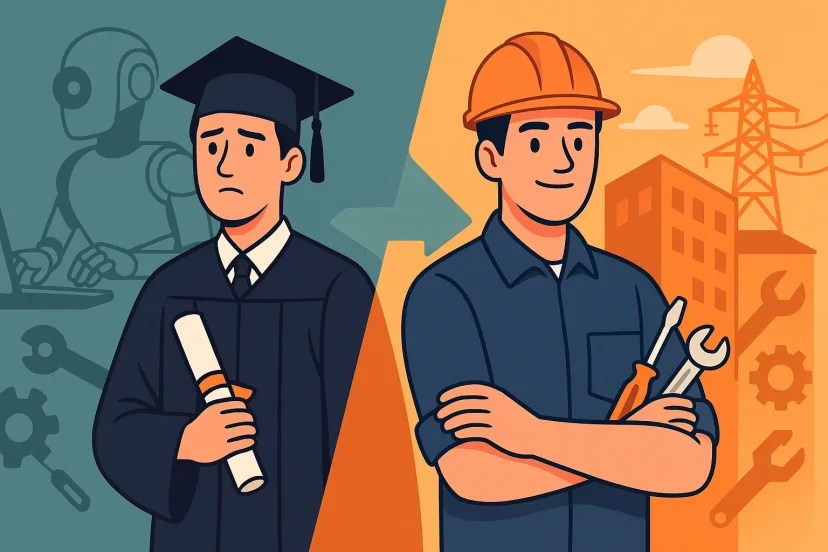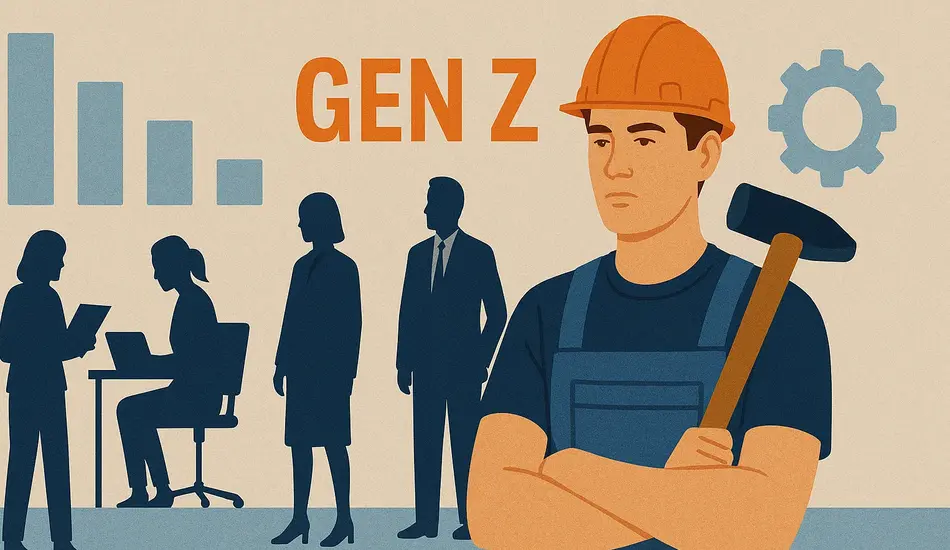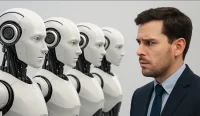AI Is Reshaping the Job Market in ways that are no longer futuristic — it is actively rewriting the American workforce today. From management consulting firms to retail hiring systems, AI is disrupting traditional white-collar work while simultaneously reshaping how younger workers, particularly Gen Z, view their career options.
A recent study by McKinsey & Company estimated that 30% of the tasks workers perform today could be automated within just three years. The shift is already happening: more than 10,000 jobs were lost in July alone due to AI adoption. For younger workers, the response has been dramatic — many are reconsidering careers in skilled trades like electrical work, plumbing, and welding, fields once overlooked in favor of college-educated office roles.
AI Is Reshaping the Job Market: Consulting Giants Under Pressure
Few industries illustrate AI’s disruption more than management consulting. Firms like McKinsey and others traditionally rely on armies of highly paid consultants to analyze data, create reports, and advise executives. Increasingly, AI can complete much of that work — from drafting insights to running predictive models — in a fraction of the time.
This development raises existential questions for professional services. If clients can access similar insights through AI platforms at a fraction of the cost, how will consulting firms justify premium billing rates? The shake-up underscores the larger trend: AI is eating into white-collar industries once considered untouchable.
Hire Talent That Thrives Alongside AI
Post your job on WhatJobs and connect with professionals who bring strategic value beyond what automation can deliver.
Post a Job Now →Gen Z Reimagines Success
For Gen Z, the AI revolution is forcing a redefinition of what a “good career” looks like. A survey found that 65% of Gen Z do not believe their college degree will protect them from AI-related job loss.
More than half of Gen Z workers now say they are seriously considering blue-collar or skilled trade work. Roles such as electricians, welders, and technicians are seen as relatively safe from automation — at least for now — since they require hands-on, physical skills that AI and robotics cannot easily replicate.
Take Cameron Vogel, an electrician from Tennessee. Traveling the country with Energize US EDU, Vogel argues that trades offer not only stability but also pride and opportunity. “AI can write reports and screen resumes, but it can’t rewire a building,” he said.

AI in Hiring: Promise or Discrimination?
While AI creates new efficiencies for companies, it also raises troubling questions about fairness. Derek Mobley, a job seeker who was unemployed for two years, alleges that Workday’s AI-powered hiring tools discriminated against him based on age, race, and mental health.
Mobley says he applied to countless positions — remote and in-person, across industries — but never received an interview. “The rejection rate was 100%. That just didn’t make sense,” he said.
Workday denies the claims, but a federal judge has allowed Mobley’s lawsuit to proceed as a nationwide collective action. The case highlights a growing concern: as more employers use AI to filter resumes and assess applicants, are qualified candidates being unfairly screened out before a human ever reviews their application?
The Cultural Shift: Breaking the Stigma of Trades
Even as Gen Z shows new interest in blue-collar jobs, cultural barriers remain. Many young people still see trades as “dirty work” associated with poor health outcomes or low social status. Vogel and others argue that perception is outdated. Skilled trades today offer competitive wages, entrepreneurial opportunities, and a level of security increasingly rare in white-collar roles.
The challenge is reframing these careers as aspirational, not fallback options. “AI isn’t taking electrician jobs,” one labor advocate explained. “It’s taking analyst jobs. The question is whether society catches up to that reality.”
The Bigger Picture
The rise of AI doesn’t mean an end to white-collar work, but it does mean transformation. Jobs in fields like consulting, finance, and marketing are being restructured. Instead of eliminating entire professions, AI is more likely to automate repetitive tasks, forcing humans to focus on higher-level strategy, creativity, and interpersonal skills.
Still, the disruption is uneven. For workers without in-demand skills or networks, AI threatens to intensify inequality. Those unable to pivot quickly may find themselves sidelined, while others who embrace adaptability can thrive.
FAQs: AI and the Future of Work
Q1: Which industries are most at risk from AI automation?
Industries with repetitive, data-heavy tasks — like consulting, finance, legal research, and HR — face the most disruption. Roles requiring physical presence and manual skills, such as electricians and plumbers, are less vulnerable.
Q2: Why is Gen Z turning to blue-collar jobs?
Gen Z sees trades as more resistant to automation and more reliable in the face of economic uncertainty. Rising wages in skilled trades also make them attractive alternatives to office jobs.
Q3: Are AI hiring tools discriminatory?
AI-driven hiring platforms promise efficiency but can reflect biases in their algorithms. Cases like Derek Mobley’s lawsuit against Workday suggest legal and ethical scrutiny is increasing.
Q4: How should workers prepare for an AI-driven job market?
Focus on building skills AI cannot easily replicate — creativity, critical thinking, interpersonal communication, and hands-on technical work. Continuous learning and adaptability will be key to long-term career security.
Bottom Line:
AI is disrupting white-collar work faster than many predicted. Gen Z is responding by reconsidering career paths once dismissed, while lawsuits raise questions about fairness in AI hiring. As automation accelerates, adaptability — not just degrees — will define who thrives in the workforce of the future.




